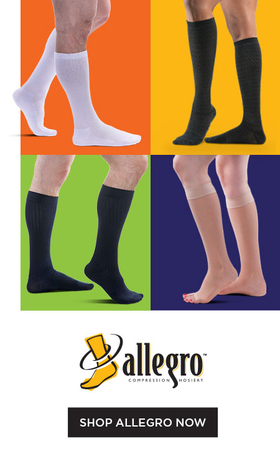What is compression? What compression level do you need?
Compression garments use graduated compression to promote venous return and prevent edema. Graduated compression means that the pressure applied from the stockings is greatest at the bottom of the legs, near the ankle, and gradually decreases further up the leg. This allows for blood to be pushed back up the leg toward the heart, resulting in better blood flow and relieving pain caused by poor blood circulation.
What are compression levels?
Compression levels, the amount of pressure applied to your extremities, are measured in millimeters of mercury (mmHg). The larger the number, the higher the compression. The different compression levels serve different purposes. They’re often prescribed by doctors for specific medical conditions, but they have non-medical advantages, too. At the bottom of this page is a chart that lays out the conditions compression garments are commonly prescribed for as well as the level of compression recommended for these conditions.
8-15 mmHg: This is the lightest form of compression, which is great for energizing your legs. Socks in this compression level provide relief from tired and achy legs. They also help control minor swelling by gently enhancing circulation in the legs.
15-20 mmHg: The moderate compression of 15-20 mmHg provides relief from minor to moderate swelling, aching, and varicose veins, especially during pregnancy. They are great for preventing deep vein thrombosis (or economy class syndrome) while traveling, but they’re also good for anyone who stands or sits for long periods of time.
20-30 mmHg: The most frequently prescribed level, 20-30 mmHg compression socks offer firm compression and can be used to treat a variety of mild to moderate conditions. This level can provide relief from varicose veins, edema, deep vein thrombosis, and post-sclerotherapy. This level is also referred to as Class I or firm compression.
30-40 mmHg: Sometimes referred to as Class II compression, 30-40 mmHg socks are often prescribed to provide relief from moderate to severe edema, varicose veins, and deep vein thrombosis. They’re also prescribed for post-sclerotherapy and to heal active venous stasis ulcers. This level of compression should only be worn under a doctor’s supervision.
40-50 mmHg: This is the highest level of compression we offer and should only be worn if prescribed by a doctor. This level is typically used to treat chronic venous insufficiency and post-thrombotic syndrome. Your doctor might refer to this level as Class III.
What strength of compression do you need?
The following charts show conditions compression garments are routinely prescribed to treat as well as the compression level(s) commonly used for treatment. This information should just be used to start the conversation with your doctor - always confirm with your healthcare provider before wearing compression.
Please note: The information provided here is for general reference only and is not meant to act as medical advice.
If you still have questions we have answers:
Which compression socks are best for you?
How many hours a day should you wear compression?
Or, call us, we are here to help: 1-877-545-8585






